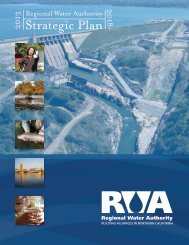A Homeowner's Guide to a WaterSmart Landscape
You also want an ePaper? Increase the reach of your titles
YUMPU automatically turns print PDFs into web optimized ePapers that Google loves.
verify your new landscape<br />
water use<br />
Now that you have designed your <strong>WaterSmart</strong><br />
landscape, it is important <strong>to</strong> confirm that your design<br />
meets the landscape water use goal you set in Step 1,<br />
and if necessary, adjust your design <strong>to</strong> maximize your<br />
water savings.<br />
Weather-based controllers often have a sensor that should be mounted<br />
outside, free of obstructions, and connected <strong>to</strong> the controller.<br />
<br />
Smart controller. Upgrade <strong>to</strong> a smart controller<br />
(often called a weather-based controller), which is<br />
an au<strong>to</strong>matic controller (also called a timer or clock)<br />
that is weather-based and au<strong>to</strong>matically adjusts the<br />
watering schedule in response <strong>to</strong> environmental<br />
changes. Smart controllers have the ability <strong>to</strong><br />
interrupt the watering schedule and prevent<br />
sprinklers from running when it rains. They can also<br />
increase the frequency and/or duration of watering<br />
in hotter weather. Locate the controller in a place<br />
that is easily accessible, such as the garage.<br />
<br />
Irrigation layout. The goal of <strong>WaterSmart</strong><br />
irrigation is <strong>to</strong> apply water as efficiently as possible.<br />
This means using low-flow drip irrigation whenever<br />
possible. In areas with overhead spray, provide<br />
even coverage <strong>to</strong> ensure maximum efficiency.<br />
Once you have determined what type of irrigation<br />
equipment you would like <strong>to</strong> use, divide your yard<br />
in<strong>to</strong> hydrozones and note what type of irrigation<br />
you plan <strong>to</strong> use in each zone. Contact irrigation<br />
manufacturers <strong>to</strong> inquire if they offer an irrigation<br />
design guide, which can be helpful <strong>to</strong> determine<br />
the specifics of your irrigation layout. Some<br />
manufacturers offer free irrigation design services.<br />
<br />
Verify your overall plant water use. Review your<br />
planting design and determine, based on area, what<br />
percentage of plants are very low, low, moderate,<br />
or high water use. If the planting plan you selected<br />
does not fit exactly in<strong>to</strong> one of the categories below,<br />
adjust the plant selection so that it does, or select<br />
the category that represents the higher water use<br />
category.<br />
<br />
Verify your overall irrigation efficiency. Review<br />
your irrigation design and note below what type of<br />
irrigation you selected.<br />
Planting<br />
“Low”<br />
“moderate”<br />
and “high”<br />
water use<br />
plants<br />
“Low”<br />
water use<br />
plants<br />
Irrigation<br />
Low<br />
efficiency<br />
irrigation<br />
not<br />
<strong>WaterSmart</strong><br />
Moderate<br />
efficiency<br />
irrigation<br />
High<br />
efficiency<br />
irrigation<br />
| step 4<br />
Layout Tips<br />
Do not mix different sprinkler types within the same<br />
valve zone. Do not mix low-volume drip emitters and<br />
spray heads on the same zone. Key elements <strong>to</strong> locate<br />
on your layout plan are the locations of mainline pipes<br />
(pressurized) and lateral line pipes (non-pressurized,<br />
except when valves are open), the point of connection <strong>to</strong><br />
your household water supply, and backflow preventer, if<br />
required.<br />
“Very low”<br />
water use<br />
plants<br />
<strong>WaterSmart</strong> Drop Rating<br />
22



